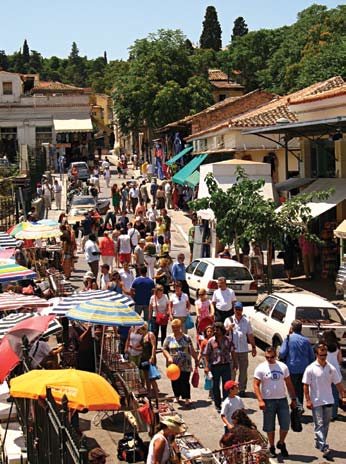
The historic neighbourhood of Plaka embosoms the Acropolis Hill on
all sides. Together with Monastiraki, they contain an endless variety
of antiquities of all eras. Plaka is the last remaining neighbourhood of
the city which retains the neoclassical architectural style of old Athens.
A walk through its winding streets is a glimpse in the way people lived
and interacted with one another in the geitonia (neighbourhood) when
everyone knew their neighbours and a daily stop at the café was a ritual.
Perched right under the Acropolis is the odd Anafiotika quarter, a quiet
area with whitewashed Cycladic-style houses. These small houses were
built by stone masons from the Cycladic island of Anafi in the mid 19th
century, who arrived in Athens to build the royal palace after the country’s
independence. The beautiful white church of Agios Georgios marks the
area from afar. Walking towards the train lines, you enter Monastiraki,
the biggest open-air museum in the country. On Adrianou Street you
will find the Ancient Agora, the centre of government in ancient Athens,
while the amazing Temple of Hephestos, built in 449 B.C., is the best
preserved Doric temple in Greece. At the corner of Eolou and Adrianou
you see the Roman Agora and the octagonal Tower of the Winds that is
said to have been a sundial and water clock. The beautiful Fethiye Djami
(mosque) is one of the few examples of Ottoman temples that survive.
